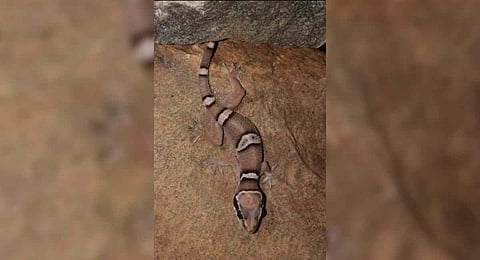

BHUBANESWAR: A group of researchers has discovered a new species of large-bodied tuberculate gecko, commonly known as termite hill gecko, in north Odisha. This is the first endemic gecko to be found from the Chota Nagpur plateau.
The new and genetically distinct species - Hemidactylus paucifasciatus is different from other species found in the region for its body size and morphological characteristics. Of the 203 species of geckos found in the country so far, 11 species have been recorded from the state.
The researchers, including scientists from the Zoological Survey of India (ZSI), Mumbai-based Thackeray Wildlife Foundation, Bengaluru-based Tata Institute of Fundamental Research and Assam Don Bosco University have described the new species in a recent publication in the international journal Zootaxa.
They have studied three specimens (an adult male, female and a sub-adult female). This gecko species grows up to a body length up to 11.8 cm and tail up to 20 cm. The animals were recorded from Gadachandi temple in Anandapur and Ghatagaon forests in Keonjhar, Bangiriposi in Similipal biosphere reserve and Kuldiha wildlife sanctuary.
Scientist E of ZSI, Kolkata Pratyush Mohapatra said Hemidactylus paucifasciatus is the first endemic Hemidactylus from Odisha and the second endemic gecko in the state after Hemiphyllodactylus minimus, which was recorded by the same team in 2020.
“This species is also the first endemic reptile of the Chota Nagpur Plateau biogeographic province. Additional surveys in the neighbouring states of Jharkhand and West Bengal need to be conducted to ascertain how widely the species is distributed,” he said.
Odisha represents an amalgamation of three biogeographic zones comprising four provinces. Mahanadi river dissects the state latitudinally and the northern region is part of the Chota Nagpur plateau biogeographic province.
Retired professor Sushil Kumar Dutta, who is also a part of the research team, said although the new species is known to occur in a few protected areas, there are potential threats to the species due to tourism activities, forest fire and possibly due to illicit timber felling.
The specimens have been deposited in the national zoological collections of the ZSI, Kolkata and Jabalpur, Madhya Pradesh and in the museum and research collection facility at the National Centre for Biological Sciences, Bengaluru.